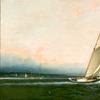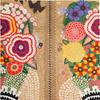CHRISTIE’S PRESENTS THE MARCH SALE OF JAPANESE AND KOREAN ART
- NEW YORK, New York
- /
- February 28, 2013
On 20 March, Christie’s will present the Spring sale of Japanese and Korean Art, which contains over 290 of the finest examples of painted screens, scrolls, calligraphy, woodcut prints, ceramics, lacquer, armor, and swords. Among the Japanese highlights are a 19th century gold lacquer display cabinet and a large bronze and mixed-metal hanging vase, while the Korean portion of the sale includes a rare massive white porcelain jar and a mixed media work by Park Sookeun, entitled Five Seated Figures.
The Japanese section of the sale is led by an elaborate large bronze and mixed-metal hanging vase, formed as a large gourd entwined with a vine, 50 in. (127cm) long (estimate: $300,000-400,000). The work, which features a finely carved snake in pursuit of a mouse, was executed in the Meiji period (late 19th century) by Shoami Katsuyoshi. Katsuyoshi followed his father’s occupation a successful sword-fitting metal worker for the first part of his career. In 1871, however, following the prohibition against wearing swords, he turned to the manufacture of other items of metal, including tea ceremony equipment, small personal accessories, and ornaments. There exist a number of works by Katsuyoshi that have leaves and wildlife included in the design, such as this example, with its exquisitely carved snake scrolling up the gourd toward a mouse hidden under a leaf, as well as a similar iron gourd that is housed in the British Museum. Over the course of his career, Katsuyoshi became particularly skillful at gold and silver inlay. In addition to being lauded at domestic and international expositions, some of his works were even acquired by the Imperial Household.
A gold lacquer display cabinet, kazaridana, was completed in the 19th century Edo period (estimate: $200,000-300,000) and features a set of shelves with two compartments that are carved with the famed landscapes of Yoshino and the Tatsuta River. Long celebrated for its beauty in Japanese poetry, Yoshino boasts one hundred thousand white cherry blossom trees, which burst into bloom for two weeks each spring. In its depiction of Yoshino, the cabinet displays the landscape with its magnificent trees, hills, rivers, mountain cottages, and footbridges. The autumn counterpart to Yoshino is the scenery of the Tatsuta River. Featured on the back panels on the interior of the cabinets, the peaceful rendering includes the riverbanks filled with red maple trees and flowing leaves.
A selection of 34 woodblock prints from the Collection of William Sturgis Bigelow is being sold by the Museum of Fine Arts, Boston, for the benefit of the collection with estimates ranging from $400 to $5,000. The prints were all purchased by renowned Boston collector, William Sturgis Bigelow (1850-1926). Bigelow traveled widely throughout Japan and lived there for seven years, studying Japanese art and culture, and he converted to the Tendai sect of Buddhism. By 1911, he gave the Museum of Fine Arts, Boston the bulk of his collection, including an estimated 40,000 prints and 450 ukiyo-e paintings, as well as some 15,000 other Chinese and Japanese works of art.
A pair of six-panel screens from the 17th century Edo period , 59 ½ x 143in. (151.1 x 363.2 cm) each (estimate: $100,000-150,000), depict the iconic battles of Ichinotani and Yashima, which took place in 1184 at the end of a grueling five-year war between two rival clans, the Taira (Heike) and the Minamoto (Genji). When the Minamoto emerged victorious, their leader, Yoritomo, became the first shogun of the new military government. A century later, the battles were immortalized in the 13th century historical novel The Tale of the Heike. The right screen illustrates the battle in the spring at Ichinotani (near present-day Kobe), while the left screen depicts the Taira retreat to Yashima, following their defeat.
Highlighting the Korean portion of the sale is a selection of exquisite porcelains, including a rare massive white porcelain jar from the 18th century Joseon dynasty, standing nearly two-feet tall (estimate on request). The jar, which exhibits a blue cast where glaze has been more thickly applied, is remarkable for its distinctive height and girth. There have been few comparable examples published, including one from the collection of the Nihon Mingeikan in Tokyo. Also among the porcelain highlights is a large jar painted with flora and fauna in medium tones of underglaze blue, Joseon dynasty, 18th/19th century (estimate: $350,000-400,000). The two flowers chosen for this jar, the orchid and the chrysanthemum, are two of the four, with the bamboo and plum, that represent the honor and virtue of the literatus.
A blue and white porcelain bottle from the 19th century Joseon dynasty beautifully depicts the Ten Signs of Long Life (shipjangsaeng), including a deer, a bullocho fungus, pines, bamboo, rock, and clouds (estimate: $45,000-50,000). The technical refinement of the work testifies to the skill of the Joseon ceramic artists. The auspicious imagery is portrayed in a frieze around the octagonal body of the bottle, which stands approximately six inches tall.
From a private U.S. collection, Park Sookeun’s mixed-media painting Five Seated Figures is among the sale’s modern highlights (estimate: $400,000-500,000). A quintessential work by the artist, Five Seated Figures is modest in scale, somber, roughly textured, and unassuming. These qualities, combined with the abstract, simplified rendering of his idyllic scenes of everyday life, not only contribute to the poetic nature of his works, but have also made them truly iconic. Since Christie’s first began selling the works of Park Sookeun nearly two decades ago, he has become the most sought-after modern Korean master.




10270x400_c.jpg)







_-Closing-the-Distance_100x100_c.jpg)









